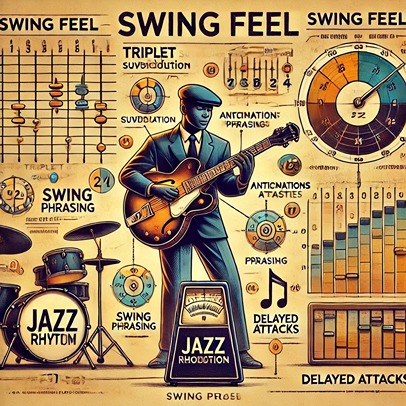How to Improve Your Swing Feel
/by Dennis WingeSwing feel is one of the most defining characteristics of jazz rhythm, yet it remains elusive for many players. Some musicians naturally internalize the swing pulse, while others need dedicated practice to break out of rigid, “square” playing. Whether comping chords or playing single-note lines, the ability to swing is essential for achieving an authentic jazz sound. This guide will explore how to develop a better swing feel through listening, rhythmic exercises, and specific comping techniques.
Understanding Swing Feel
At its core, swing feel is based on the triplet subdivision. Instead of evenly spaced eighth notes as in rock or classical music, jazz eighth notes are uneven, with the first eighth note being longer than the second. The exact ratio can vary depending on tempo and style, but thinking in terms of a triplet subdivision (where the beat is divided into three equal parts) helps conceptualize swing.
Moreover, swing is not just about note duration but also about phrasing, accents, and feel. Players with a strong swing feel tend to anticipate and delay rhythms in a natural, fluid way rather than placing every beat rigidly in time.
Exercises to Develop Swing Feel
To help loosen up a rigid rhythmic approach, we’ll explore a series of exercises designed to internalize swing, using a | Bb7 | Eb7 | vamp for practice.
1. Anticipation
One key element of swing comping is rhythmic anticipation—striking chords before the downbeat to create a forward motion.
- Anticipate all chords (except the very first bar) by an eighth note (i.e., play on “and of 4”).
- Anticipate all chords (except the very first bar) by a quarter note (i.e., play on “4”).
- Mix up anticipation types by alternating between “and of 4” and “4.”
- Combine anticipation with non-anticipated hits to develop a natural, swinging feel.
2. Delayed Attacks
Another technique to enhance swing feel is delaying chord hits slightly after the expected beat.
- Delay all chords (except the very first bar) by an eighth note (i.e., play on “and of 1”).
- Delay all chords (except the very first bar) by a quarter note (i.e., play on “2”).
- Mix up delays by alternating between “and of 1” and “2.”
- Combine delayed hits with anticipated and on-beat hits to create a sense of rhythmic elasticity.
3. Varying On- and Off-Beat Emphasis
To avoid rigidity, jazz guitarists should aim for a balance between on- and off-beat strumming.
- Try structuring bars so that approximately 50% of strums land on the beat and 50% land off the beat.
- Example: |1 & (2) & 3 (&) 4 & |(1) & 2 (&) 3 & (4 &) |
- The goal is not to mathematically plan every hit but to develop a feel for variation.
4. The Freddie Green Strum
Freddie Green, the legendary rhythm guitarist for Count Basie, developed a simple yet highly effective approach to swinging comping.
- Play |1–|2-x|3–|4-x| where “x” is a muted percussive strum.
- Notice the implicit triplet subdivision: 1 & a 2 & a 3 & a 4 & a.
- This emphasizes that the jazz quarter note pulse is functionally a dotted quarter note in 12/8.
5. Accenting the Swing Subdivision
Another effective exercise is to emphasize different parts of the triplet subdivision to internalize swing phrasing.
- Play only on beats 2 and 4, plus the third part of the triplet (|—|2-a|—|4-a|).
- Play only on beats 2 and 4 (|—|2–|—|4–|), reinforcing the classic jazz comping feel.
- Play only on the third part of each triplet beat (|–a|–a|–a|–a|) to highlight the swing subdivision.
6. Metronome Techniques for Swing
Practicing with a metronome in creative ways can help internalize swing.
- Set the metronome to click on beats 2 and 4 instead of 1 and 3.
- Play at extremely slow tempos while maintaining swing feel—this helps reinforce internal timing.
- Use a backing track with a strong swing groove and try locking in with the rhythm section.
7. Listening and Transcribing
Swing is best learned by immersion. Encourage deep listening to legendary rhythm players:
- Guitarists: Freddie Green, Jim Hall, Grant Green, Kenny Burrell.
- Pianists: Wynton Kelly, Red Garland, Count Basie (left-hand comping).
- Drummers: Philly Joe Jones, Art Blakey (listen to how ride cymbals dictate swing feel).
Transcribing comping patterns from recordings is one of the best ways to absorb natural swing.
Applying Swing to Real Playing
To integrate these exercises into musical contexts:
- Comp over real tunes instead of isolated vamps.
- Trade fours with a friend or teacher, comping and soloing alternately.
- Play along with recordings and try to blend into the rhythm section.
- Experiment with dynamics—subtle volume changes enhance swing feel.
Conclusion
Improving your swing feel requires a combination of technical exercises, listening, and playing in context. By practicing anticipation, delay, subdivision exercises, and the Freddie Green strum, you can loosen up rigid rhythms and develop a more authentic jazz comping style. The key is to internalize the feel rather than just executing rhythms mechanically. With consistent practice, you’ll transform your rhythm playing into a grooving, swinging force that enhances any jazz ensemble.
Book a free trial lesson, available both in-person and online. Fill out this form and we’ll respond within 24 hours.

